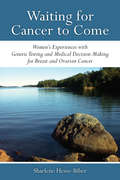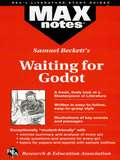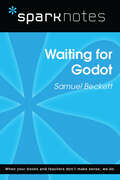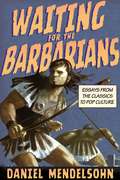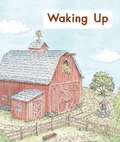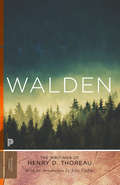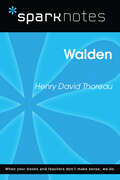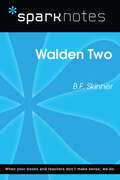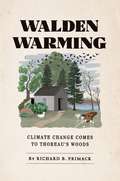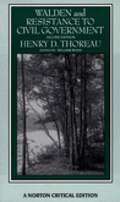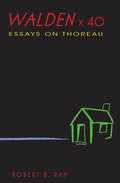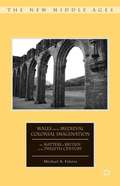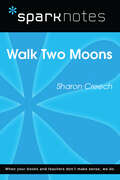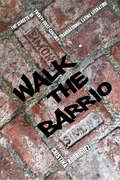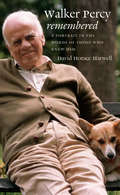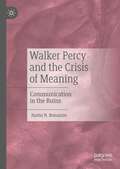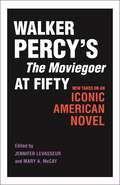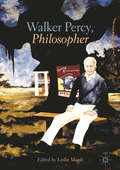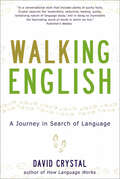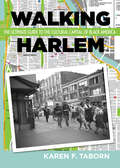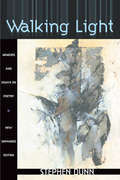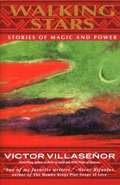- Table View
- List View
Waiting for Cancer to Come: Women’s Experiences with Genetic Testing and Medical Decision Making for Breast and Ovarian Cancer
by Sharlene Hesse-BiberWaiting for Cancer to Come tells the stories of women who are struggling with their high risk for cancer. Based on interviews and surveys of dozens of women, this book pieces together the diverse yet interlocking experiences of women who have tested positive for the BRCA 1/2 gene mutations, which indicate a higher risk of developing breast and ovarian cancer. Sharlene Hesse-Biber brings these narratives to light and follows women's journeys from deciding to get screened for BRCA, to learning the test has come back positive, to dealing with their risk. Many women already know the challenges of a family history riddled with cancer and now find themselves with the devastating knowledge of their own genetic risk. Using the voices of the women themselves to describe the under-explored BRCA experience, Waiting for Cancer to Come looks at the varied emotional, social, economic, and psychological factors at play in women's decisions about testing and cancer prevention.
Waiting for Godot (MAXNotes Literature Guides)
by Rita WilenskyREA's MAXnotes for Samuel Becketts's Waiting for Godot MAXnotes offer a fresh look at masterpieces of literature, presented in a lively and interesting fashion. Written by literary experts who currently teach the subject, MAXnotes will enhance your understanding and enjoyment of the work. MAXnotes are designed to stimulate independent thought about the literary work by raising various issues and thought-provoking ideas and questions. MAXnotes cover the essentials of what one should know about each work, including an overall summary, character lists, an explanation and discussion of the plot, the work's historical context, illustrations to convey the mood of the work, and a biography of the author. Each chapter is individually summarized and analyzed, and has study questions and answers.
Waiting for Godot (SparkNotes Literature Guide Series)
by SparkNotesWaiting for Godot (SparkNotes Literature) by Samuel Beckett Making the reading experience fun! Created by Harvard students for students everywhere, SparkNotes is a new breed of study guide: smarter, better, faster. Geared to what today's students need to know, SparkNotes provides: *Chapter-by-chapter analysis *Explanations of key themes, motifs, and symbols *A review quiz and essay topicsLively and accessible, these guides are perfect for late-night studying and writing papers
Waiting for the Barbarians: Essays from the Classics to Pop Culture
by Daniel MendelsohnOver the past decade and a half, Daniel Mendelsohn's reviews for The New York Review of Books, The New Yorker, and The New York Times Book Review have earned him a reputation as "one of the greatest critics of our time" (Poets& Writers). In Waiting for the Barbarians, he brings together twenty-four of his recent essays--each one glinting with "verve and sparkle," "acumen and passion"--on a wide range of subjects, from Avatar to the poems of Arthur Rimbaud, from our inexhaustible fascination with the Titanic to Susan Sontag's Journals. Trained as a classicist, author of two internationally best-selling memoirs, Mendelsohn moves easily from penetrating considerations of the ways in which the classics continue to make themselves felt in contemporary life and letters (Greek myth in the Spider-Man musical, Anne Carson's translations of Sappho) to trenchant takes on pop spectacles--none more explosively controversial than his dissection of Mad Men.Also gathered here are essays devoted to the art of fiction, from Jonathan Littell's Holocaust blockbuster The Kindly Ones to forgotten gems like the novels of Theodor Fontane. In a final section, "Private Lives," prefaced by Mendelsohn'sNew Yorker essay on fake memoirs, he considers the lives and work of writers as disparate as Leo Lerman, Noël Coward, and Jonathan Franzen. Waiting for the Barbarians once again demonstrates that Mendelsohn's "sweep as a cultural critic is as impressive as his depth."
Waking Up (Fountas & Pinnell LLI Green #Level A, Lesson 1)
by Sula DanielFountas and Pinnell Leveled Literacy Intervention Green System -- 1st Grade
Walden
by Henry D. ThoreauOne of the most influential and compelling books in American literature, Walden is a vivid account of the years that Henry D. Thoreau spent alone in a secluded cabin at Walden Pond. This edition--introduced by noted American writer John Updike--celebrates the perennial importance of a classic work, originally published in 1854. Much of Walden's material is derived from Thoreau's journals and contains such engaging pieces from the lively "Where I Lived, and What I Lived For" and "Brute Neighbors" to the serene "Reading" and "The Pond in the Winter." Other famous sections involve Thoreau's visits with a Canadian woodcutter and with an Irish family, a trip to Concord, and a description of his bean field. This is the complete and authoritative text of Walden--as close to Thoreau's original intention as all available evidence allows. This is the authoritative text of Walden and the ideal presentation of Thoreau's great document of social criticism and dissent.
Walden
by Henry David Thoreau Stephen FenderIn 1845 Henry David Thoreau began a new life, spending most of each week for over two years in a rough hut he built himself on the northwest shore of Walden Pond, just a mile and a half from his home town of Concord, Massachusetts. Walden is Thoreau's autobiographical account of this experiment in solitary living, his refusal to play by the rules of hard work and the accumulation of wealth and, above all, the freedom it gave him to adapt his living to the natural world around him. This new edition traces the sources of Thoreau's reading and thinking and considers the author in the context of his birthplace and his sense of its history - social, economic, and natural. In addition, an ecological appendix provides modern identifications of the myriad plants and animals to which Thoreau gave increasingly close attention as he became acclimatized to his life at Walden. Long-revered by political reformers and environmentalists, Walden is here reassessed by Stephen Fender, whose edition is based on research into the material conditions of Thoreau's life in Concord, and the town's place in the history of mid-nineteenth-century New England. [This text is listed as an example that meets Common Core Standards in English language arts in grades 11-12 at http://www.corestandards.org.]
Walden (SparkNotes Literature Guide Series)
by SparkNotesWalden (SparkNotes Literature Guide) by Henry David Thoreau Making the reading experience fun! Created by Harvard students for students everywhere, SparkNotes is a new breed of study guide: smarter, better, faster. Geared to what today's students need to know, SparkNotes provides chapter-by-chapter analysis; explanations of key themes, motifs, and symbols; and a review quiz and essay topics. Lively and accessible, these guides are perfect for late-night studying and writing papers.
Walden Two (SparkNotes Literature Guide Series)
by SparkNotesWalden Two (SparkNotes Literature Guide) by B.F. Skinner Making the reading experience fun! Created by Harvard students for students everywhere, SparkNotes is a new breed of study guide: smarter, better, faster. Geared to what today's students need to know, SparkNotes provides: *Chapter-by-chapter analysis *Explanations of key themes, motifs, and symbols *A review quiz and essay topicsLively and accessible, these guides are perfect for late-night studying and writing papers
Walden Warming: Climate Change Comes to Thoreau's Woods
by Richard B. PrimackIn his meticulous notes on the natural history of Concord, Massachusetts, Henry David Thoreau records the first open flowers of highbush blueberry on May 11, 1853. If he were to look for the first blueberry flowers in Concord today, mid-May would be too late. In the 160 years since Thoreau’s writings, warming temperatures have pushed blueberry flowering three weeks earlier, and in 2012, following a winter and spring of record-breaking warmth, blueberries began flowering on April 1--six weeks earlier than in Thoreau’s time. The climate around Thoreau’s beloved Walden Pond is changing, with visible ecological consequences. In Walden Warming, Richard B. Primack uses Thoreau and Walden, icons of the conservation movement, to track the effects of a warming climate on Concord’s plants and animals. Under the attentive eyes of Primack, the notes that Thoreau made years ago are transformed from charming observations into scientific data sets. Primack finds that many wildflower species that Thoreau observed--including familiar groups such as irises, asters, and lilies--have declined in abundance or have disappeared from Concord. Primack also describes how warming temperatures have altered other aspects of Thoreau’s Concord, from the dates when ice departs from Walden Pond in late winter, to the arrival of birds in the spring, to the populations of fish, salamanders, and butterflies that live in the woodlands, river meadows, and ponds. Primack demonstrates that climate change is already here, and it is affecting not just Walden Pond but many other places in Concord and the surrounding region. Although we need to continue pressuring our political leaders to take action, Primack urges us each to heed the advice Thoreau offers in Walden: to "live simply and wisely. ” In the process, we can each minimize our own contributions to our warming climate.
Walden and Resistance to Civil Government
by Henry D. ThoreauFor this second edition, the volume previously edited by the late Owen Thomas has been updated in every respect. A few changes have been made to the Walden text, based on comparisons with prior manuscript versions and with Thoreau's corrected page proofs and additions to his own copy of the book. These and all other emendations of the 1854 text of Walden are summarized in a table of textual variants. The original placement of Thoreau's map of Walden Pond and the title of his famous essay have been restored, and annotations for both texts have been added or revised as necessary. This second edition features an expanded selection of passages from Thoreau's Journal, composed over the entire nine-year period during which he wrote, rethought, and extensively revised Walden and in which the Journal itself became a distinct imaginative work.
Walden x 40: Essays on Thoreau
by Robert B. RayProvocative and illuminating essays on Thoreau&’s masterwork, shedding new light on its enduring inspiration and philosophical depth. In 1845, Henry David Thoreau moved from his parents&’ house in Concord, Massachusetts, to a one-room cabin he built himself on the land of his mentor, Ralph Waldo Emerson. He described his time there, just over two years, as an experiment in &“living deliberately.&” His daily journal entries became the source material for Walden, a masterful meditation on the virtues of simplicity, self-sufficiency, and man&’s relationship to nature. In Walden x 40, Robert B. Ray adopts Thoreau&’s compositional method to explore some of the questions posed in Walden. Drawing connections to the works of poets and philosophers from Wordsworth to Wittgenstein, Nietzsche, and Breton, Ray derives the inspiration for his 40 brief essays by exploring the pages of Walden in the same way Thoreau explored his own life—deliberately.
Walden's Shore
by Robert M. Thorson"Let us settle ourselves, and work and wedge our feet downward," Thoreau invites his readers in "Walden," "till we come to a hard bottom and rocks in place, which we can call "reality. "" "Waldens Shore" explores Thoreaus understanding of that hard reality, not as metaphor but as physical science. Robert M. Thorson is interested in Thoreau the rock and mineral collector, interpreter of landscapes, and field scientist whose compass and measuring stick were as important to him as his plant press. At "Walden"s climax, Thoreau asks us to imagine a "living earth" upon which all animal and plant life is parasitic. This book examines Thoreaus understanding of the geodynamics of that living earth, and how his understanding informed the writing of "Walden. " The story unfolds against the ferment of natural science in the nineteenth century, as Natural Theology gave way to modern secular science. That era saw one of the great blunders in the history of American science--the rejection of glacial theory. Thorson demonstrates just how close Thoreau came to discovering a "theory of everything" that could have explained most of the landscape he saw from the doorway of his cabin at Walden. At pivotal moments in his career, Thoreau encountered the work of the geologist Charles Lyell and that of his protege Charles Darwin. Thorson concludes that the inevitable path of Thoreaus thought was descendental, not transcendental, as he worked his way downward through the complexity of life to its inorganic origin, the living rock.
Wales and the Medieval Colonial Imagination
by Michael A. FaletraFocusing on works by some of the major literary figures of the period, Faletra argues that the legendary history of Britain that flourished in medieval chronicles and Arthurian romances traces its origins to twelfth-century Anglo-Norman colonial interest in Wales and the Welsh.
Walk Two Moons (SparkNotes Literature Guide Series)
by SparkNotesWalk Two Moons (SparkNotes Literature Guide) by Sharon Creech Making the reading experience fun! Created by Harvard students for students everywhere, SparkNotes is a new breed of study guide: smarter, better, faster. Geared to what today's students need to know, SparkNotes provides: *Chapter-by-chapter analysis *Explanations of key themes, motifs, and symbols *A review quiz and essay topicsLively and accessible, these guides are perfect for late-night studying and writing papers
Walk the Barrio: The Streets of Twenty-First-Century Transnational Latinx Literature (Cultural Frames, Framing Culture)
by Cristina RodriguezImmigrant communities evince particular and deep relationship to place. Building on this self-evident premise, Walk the Barrio adds the less obvious claim that to write about place you must experience place. Thus, in this book about immigrants, writing, and place, Cristina Rodriguez walks neighborhood streets, talks to immigrants, interviews authors, and puts herself physically in the spaces that she seeks to understand.The word barrio first entered the English lexicon in 1833 and has since become a commonplace not only of American speech but of our literary imagination. Indeed, what draws Rodriguez to the barrios of Los Angeles, New York, Miami, and others is the work of literature that was fueled and inspired by those neighborhoods. Walk the Barrio explores the ways in which authors William Archila, Richard Blanco, Angie Cruz, Junot Díaz, Salvador Plascencia, Héctor Tobar, and Helena María Viramontes use their U.S. hometowns as both setting and stylistic inspiration.Asking how these writers innovate upon or break the rules of genre to render in words an embodied experience of the barrio, Rodriguez considers, for example, how the spatial map of New Brunswick impacts the mobility of Díaz’s female characters, or how graffiti influences the aesthetics of Viramontes’s novels. By mapping each text’s fictional setting upon the actual spaces it references in what she calls "barriographies," Rodriguez reveals connections between place, narrative form, and migrancy.This first-person, interdisciplinary approach presents an innovative model for literary studies as it sheds important light on the ways in which transnationalism transforms the culture of each Latinx barrio, effecting shifts in gender roles, the construction of the family, definitions of social normativity, and racial, ethnic, national, and linguistic identifications.
Walker Percy Remembered
by David Horace HarwellWalker Percy (1916-1990), the reclusive southern author most famous for his 1961 novel The Moviegoer, spent much of his adult life in Covington, Louisiana. In the spirit of traditional southern storytelling, this biography of Percy takes its shape from candid interviews with his family, close friends, and acquaintances. In thirteen interviews, we get to know Percy through his lifelong friend Shelby Foote, Percy's brothers LeRoy and Phin, his former priest, his housekeeper, and former teachers, among others--all in their own words. Over the course of the interviews, readers learn intimate details of Percy's writing process; his interaction with community members of different ethnic, religious, and socioeconomic backgrounds; and his commitment to civil rights issues. What emerges is a multidimensional portrait of Percy as a man, a friend, and a family member.
Walker Percy and the Crisis of Meaning: Communication in the Ruins
by Justin N. BonannoIn this book, Justin N. Bonanno builds off of the recent philosophical work on Walker Percy’s writings. While it is valuable to appreciate Percy as a novelist, Bonanno approaches Percy from the perspective of Continental philosophy and the rhetorical tradition. Unpacking the works of several key authors that influenced Percy (e.g. Sartre and Heidegger), Bonanno offers a fresh philosophical account of Percy's ideas concerning the relationship between symbols and existence. In particular, he focuses on how Percy’s ideas emerge from the thought of Ernst Cassirer, Susanne Langer, Jacques Maritain, Jean-Paul Sartre, Gabriel Marcel, Martin Heidegger, Viktor Shklovsky, Søren Kierkegaard, and St. Thomas Aquinas.
Walker Percy's The Moviegoer at Fifty: New Takes on an Iconic American Novel
by Jennifer Levasseur Mary A. Mccay Jay TolsonMore than fifty years after its publication, Walker Percy's National Book Award Winner, The Moviegoer, still confronts, comforts, and enlightens generations of readers. This collection of twelve new essays, edited and introduced by Jennifer Levasseur and Mary A. McCay, emphasize the evolving significance of this seminal, New Orleans novel. Authors' consider the text with diverse perspectives, drawing from philosophy, theology, disability theory, contemporary music and literature, social media, and film studies. Jay Tolson opens the volume with reflections on rereading the novel on a Kindle decades after writing his important biography of Percy. H. Collin Messer, Montserrat Gins, Jessica Hooten Wilson, and Brian Jobe follow with illuminating essays analyzing Percy's influences, from St. Augustine and Cervantes to Heidegger and Dostoevsky. Jonathan Potter and Read Mercer Schuchardt, Mary A. McCay, Matthew Luter, and Dorian Speed delve into the novel's significance to cinema, including an exhaustive guide to its film references, a meditation on Binx Bolling as a director of his existence, and the semiotics of celebrity. Brent Walter Cline and Robert Bolton, Michael Kobre, and L. Lamar Nisly present a roadmap for Bolling's inward journey, exploring a variety of elements from the role of the broken body to the spiritual connection to Bruce Springsteen lyrics. Walker Percy's The Moviegoer at Fifty is the first critical work devoted solely to the author's debut novel. Coinciding with the centenary of Percy's birth, this collection invites both new and veteran readers to enjoy The Moviegoer with fresh perspectives that underscore its lasting relevance.
Walker Percy, Philosopher
by Leslie MarshThough Walker Percy is best known as a novelist, he was first and foremost a philosopher. This collection offers a sustained examination of key aspects to his more technical philosophy (primarily semiotics and the philosophy of language) as well as some of his lesser known philosophical interests, including the philosophy of place and dislocation. Contributors expound upon Percy’s multifaceted philosophy, an invitation to literature and theology scholars as well as to philosophers who may not be familiar with the philosophical underpinnings of his work.
Walker's Rhyming Dictionary of the English Language
by J. WalkerFirst published in 1983.This is a long-established standard work of reference for poets and rhymesters.
Walking English: A Journey in Search of Language
by David CrystalFrom an acclaimed linguist, &“part travelogue, part memoir, and part meditation on the intellectual and emotional underpinnings of language. . . . Priceless.&” (Booklist) In this discursive jaunt through the groves and thickets of the English language, David Crystal creates an entertaining narrative account of his encounters with the language and its speakers. Woven from personal reflections, historical allusions, and observations of travelers, this fascinating journey through the language we use every day will have readers thinking twice about each word they speak. Starting in Wales and moving from England to San Francisco by way of, yes, Poland, Crystal encounters numerous linguistic side roads that he cannot resist exploring, from pubs to trains to Tolkien. Walking English is a captivating exploration of language by &“one of England&’s greatest living language commentators.&” (The New Statesman) &“In a conversational style that includes plenty of quirky facts, Crystal captures the exploratory, seductive, teasing, quirky, tantalizing nature of language study, and in doing so illuminates the fascinating world of words in which we live.&” —Publishers Weekly &“An informative, transformative trip into the mysterious, mutating, magical thicket of English.&” (Kirkus Reviews) &“Like passing the afternoon with a knowledgeable uncle.&” —The Wall Street Journal &“The Dr. Johnson of our age.&” —The Sunday Herald &“The book reads like a donnish Bill Bryson, a Bryson possessed with a maniacal passion for the Cambridge Encyclopedia of the English Language! . . . [A] compelling guide.&” —Independent &“Crystal proves an entertaining companion! It is pleasant to ramble with him along the byways of language.&” —The Tablet
Walking Harlem: The Ultimate Guide to the Cultural Capital of Black America
by Karen TabornWith its rich cultural history and many landmark buildings, Harlem is not just one of New York’s most distinctive neighborhoods; it’s also one of the most walkable. This illustrated guide takes readers on five separate walking tours of Harlem, covering ninety-one different historical sites. Alongside major tourist destinations like the Apollo Theater and the Abyssinian Baptist Church, longtime Harlem resident Karen Taborn includes little-known local secrets like Jazz Age speakeasies, literati, political and arts community locales. Drawing from rare historical archives, she also provides plenty of interesting background information on each location. This guide was designed with the needs of walkers in mind. Each tour consists of eight to twenty-nine nearby sites, and at the start of each section, readers will find detailed maps of the tour sites, as well as an estimated time for each walk. In case individuals would like to take a more leisurely tour, it provides recommendations for restaurants and cafes where they can stop along the way. Walking Harlem gives readers all the tools they need to thoroughly explore over a century’s worth of this vital neighborhood’s cultural, political, religious, and artistic heritage. With its informative text and nearly seventy stunning photographs, this is the most comprehensive, engaging, and educational walking tour guidebook on one of New York’s historic neighborhoods.
Walking Light: Memoirs and Essays on Poetry (American Readers Series)
by Stephen DunnCommitted to exploring the role of poetry and poets in our culture, Stephen Dunn provides new, expanded versions of the essays originally published by W. W. Norton in 1993, now out of print. In Walking Light, Dunn discusses the relationship between art and sport, the role of imagination in writing poetry, and the necessity for surprise and discovery when writing a poem. Humorous, intelligent and accessible, Walking Light is a book that will appeal to writers, readers, and teachers of poetry.Stephen Dunn is the author of eleven collection of poetry. He teaches writing and literature at the Richard Stockton College in Pomona, New Jersey, and lives in Port Republic, New Jersey.
Walking Stars: Stories of Magic and Power
by Victor VillaseñorThese are the stories of Victor Villaseñor's childhood. Magical, yet true, they are fables of endurance, defeat and triumph, spirituality, and, always, of love. Handed down through the generations, the Villaseñor's have been telling these family tales for years. Now, Victor shares them with his unmistakable storyteller style, complete with beautiful imagery and timeless significance. Set against the backdrop of the Mexican revolution and his family's migration to the United States, these stories feature a cast of unforgettable characters who have in common their perseverance and courage. They encounter the supernatural, escape persecution by rebel soldiers, endure hunger, thirst and physical stress, and ultimately, transcend their circumstances to achieve their dreams. They are indeed walking stars. Victor Villaseñor works his magic once again with these extraordinary stories. Following each story is an Author's Note, adding context and depth.
